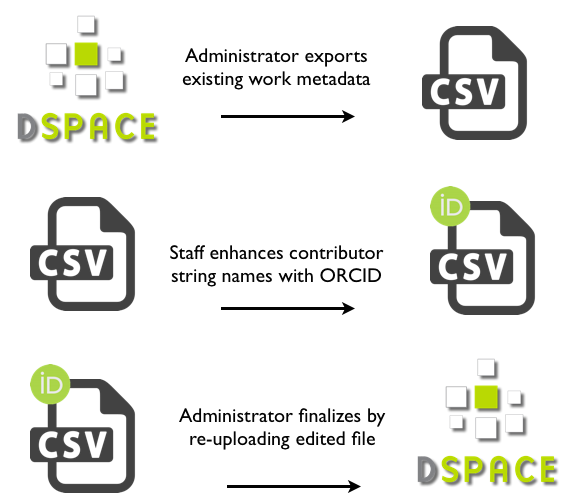Old Release
This documentation relates to an old version of DSpace, version 5.x. Looking for another version? See all documentation.
Support for DSpace 5 ended on January 1, 2023. See Support for DSpace 5 and 6 is ending in 2023
WORK IN PROGRESS
Introduction
The ORCID integration adds ORCID compatibility to the existing solutions for Authority control in DSpace. String names of authors are still being stored in DSpace metadata. The authority key field is leveraged to store a uniquely generated internal ID that links the author to more extended metadata, including the ORCID ID and alternative author names.
This extended metadata is stored and managed in a dedicated SOLR index, the DSpace authority cache.
Timeline
This functionality is still under development and is scheduled to be contributed as part of the DSpace 5 release.
Checklist: this is when you're done
Use case and high level benefits
The vision behind this project consists of the following two aspects:
Lowering the threshold to adopt ORCID for the members of the DSpace community
ORCID’s API has enabled developers across the globe to build points of integration between ORCID and third party applications. Up until today, this meant that members of the DSpace community were still required to implement front-end and back-end modifications to the DSpace source code in order to leverage these APIs. As DSpace aims to provide turnkey Institutional Repository functionality, the platform is expected to provide more functionality out of the box. Only an elite selection of members in the DSpace community has software development resources readily available to implement this kind of functionality. By contributing a solution directly to the core DSpace codebase, this threshold to adopt ORCID functionality in DSpace repositories is effectively lowered. The ultimate goal is to allow easy adoption of ORCID without customization of the DSpace software, by allowing repository administrators to enable or disable functionality by means of user friendly configuration.
Address generic use cases with appealing end user functionality
This proposal aims to provide user friendly features for both repository administrators as well as non- technical end users of the system. The addition of ORCID functionality to DSpace should not come at the cost of making the system more difficult for administrators and end users to use. Scope With this vision in mind, the project partners wanted to tackle the first phases for repository managers of existing DSpace repositories: ensuring that ORCIDs are properly associated with new works entering the system, as well as providing functionality to efficiently batch-update content already existing in the system, with unambiguous author identity information.
Installation
If it takes any work to enable the contribution, please elaborate in detail. It is recommended that you provide a good default configuration so that your configuration can run straight out of the box.
Technical Implementation Details
JSPUI Support
Right now, the functionality only includes user interface functionality for the DSpace XML User Interface.
Submission of new DSpace items - Author lookup
Editing existing items using Batch CSV Editing
Storage of related metadata
Configuration - TODO
Explain which configuration parameters are available, in which files they can be found and which procedure is required for updating. Does it require a rebuild or is a tomcat restart enough, etc?


